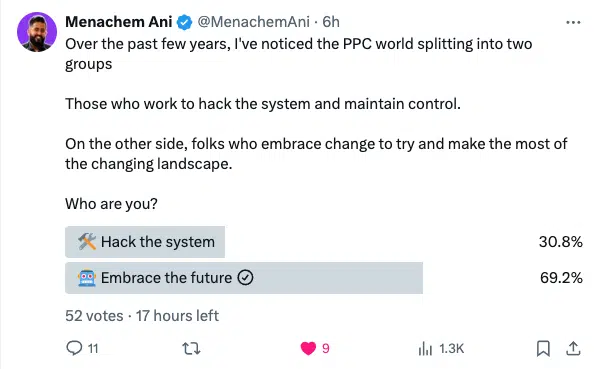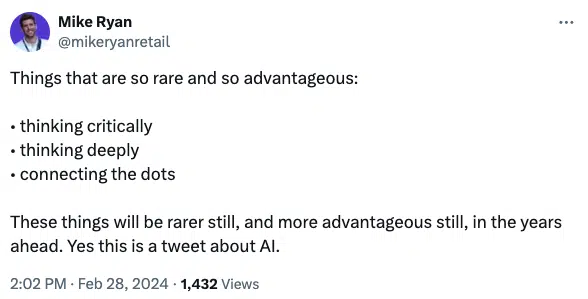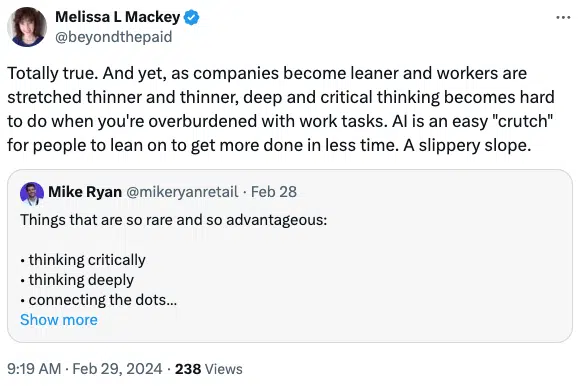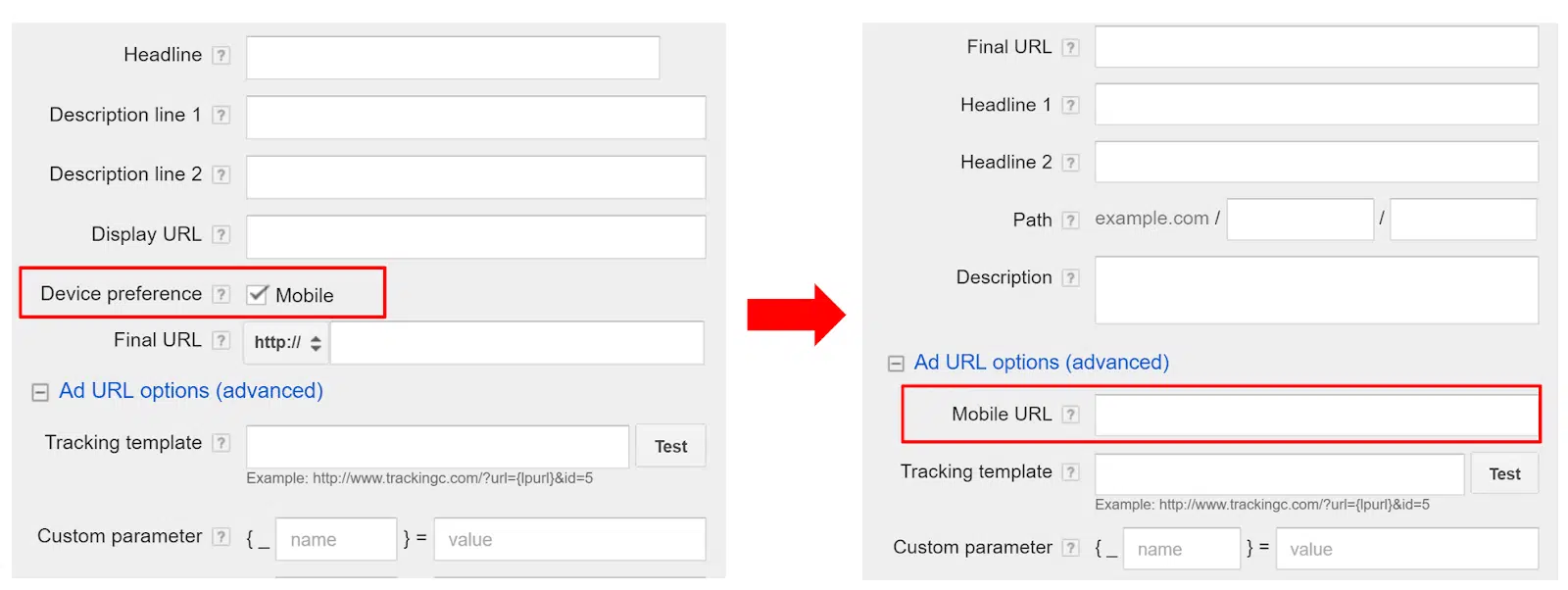Crafting winning ads is crucial for attracting the right audience, enhancing brand visibility and driving business growth in today’s highly competitive paid search landscape.
As we navigate an AI-driven world, we must adapt our strategies to create impactful ads that resonate with their target audience.
This article explores top practices and insightful tips for creating successful paid search ads in 2024, leveraging historical data, incorporating engaging visuals and aligning messaging across multiple channels.
Paid search in an AI-driven world
Effective ads attract the right audience, enhance brand visibility and sustain business growth on platforms like Google and Bing.
We just started getting comfortable with machine learning. Now, we’re learning how to create winning ads in an AI world.
Fellow Search Engine Land contributor and paid search expert Menachem Ani posted a poll on X on how the paid search community feels about the change in the past few years, and the overwhelming response is to “embrace the future.”


While this question pertains to machine learning and not specifically AI, it provides a great backdrop for the world we are working in.
So, how do we create winning ads when two layers of technology promote less human involvement?
Danny Gavin, founder and chief strategist at Optidge Internet Marketing Agency in Houston, TX, said:
- “AI should not be used without consideration in ad creation; while AI is beneficial, human input remains crucial.”
Paid search experts Melissa Mackey and Mike Ryan discuss the diminishing skill of critical thinking as we transition into an AI-driven world in the thread below.




There is a shared agreement that AI may be a support tool due to people’s busy schedules. However, both tweets reflect Gavin’s view that human involvement and critical thinking remain central.
Dig deeper: How AI is changing the game for PPC account managers
Let’s look at ways to leverage human knowledge and AI to create impactful ads this year.
1. Leverage historical data for strategic advantage
Choosing the appropriate data inputs plays a vital role in shaping the ads generated by AI.
Google and Microsoft accounts contain valuable historical performance data and examining winning assets from the past is an excellent starting point for today.
From standard text ads to responsive search ads
Initially, search ads were basic text. As time progressed, standard text ads evolved into expanded text ads.


Many accounts in 2024 are still serving both standard text ads and expanded text ads.
- Maintain older ad types until they cease serving or until the responsive search ad demonstrates a noticeable performance boost.
- Consider analyzing successful ad copy from both text ads and expanded text ads. Use the effective headlines and descriptions as a foundation for creating responsive search ads.
- Utilize AI to produce refreshed assets inspired by successful themes and content from previous ad formats, expanding choices and aligning with the character limits of 2024 ad formats.
2. Inspire feelings with images and videos
Consumers discover products through images, product feeds and videos, transforming the resources required to create campaigns that cater to every stage of the buyer’s journey.
Remember that although search ads were groundbreaking, Google’s vast ecosystem encompasses Display, the Discover feed, product feed ads, YouTube and more.
It’s nearly impossible to navigate the online space without encountering ads in the Google network.
Here are some ideas for video and image ad creative that can trigger emotions.
User-generated content (UGC)
These ads highlight the product benefits, often featuring a person with a friendly demeanor in a natural environment.
Most UGC will prompt viewers to visit the website or make a purchase.
This style of content has increased in popularity with the rise of social media and works well on YouTube and in YouTube Shorts format.
Adding text and captions is also beneficial since audiences consume content in various situations and may prefer videos without sound.
Video scripts can be generated with AI, but the essence of UGC lies in sounding authentic rather than scripted. Therefore, scripts should serve as flexible guidelines rather than rigid rules.
Dig deeper: How to reach new audiences with multi-platform search advertising
Lifestyle images
These images help users envision the product in their daily lives or establish a visual connection to a product in action.
When executed effectively, lifestyle photography evokes feelings of aspiration in users, potentially prompting them to act.
Dig deeper: Why strong Google Ads creative is THE priority for advertisers
Get the daily newsletter search marketers rely on.
3. Redefine our measures of PPC success
The notion that marketing must be entirely attributable to be effective is flawed and troublesome.
This idea presents an ongoing challenge for paid search marketers striving to demonstrate their value in a larger platform than just the search network.
Here are a few other ways for marketers to evaluate account data that are helpful when considering ad performance specifically:
Assess success through engagement
Users may not always click on ads, so gauging ad effectiveness based on engagement and viewing duration can reveal if users are watching and engaging with the video content.
Consider the interaction metrics
Ad interactions occur when users engage with ads without clicking.
These metrics are commonly viewed as superficial and may not directly indicate conversions or sales, the ultimate objectives.
Nevertheless, they can serve as early indicators of creative effectiveness.
Embracing these metrics lets brands understand the influence of creativity to create more compelling ads that capture attention.
Google defines “interactions” as:
Ultimately, interactions are memorable yet challenging to quantify, as they are often subconscious and may not be fully recognized until later.
Don’t let the intangible aspect of ad interactions overshadow a campaign’s success with the target audience.
Focus on the positive impact of ad interactions, even if they don’t always translate to immediate conversions.
Remember, brand awareness and engagement are crucial steps in the customer journey.
A look at ad interactions in a real-world context
To illustrate the concept of ad interactions, here is an advertisement that caught my attention today while watching YouTube.
The Skims ad initially displays in full color, but upon mouse hover, it transitions to a darker shade with a prominent “Shop now” call to action.




If I don’t buy immediately or online, the advertiser cannot track success.
Furthermore, if the advertiser only focused on conversions as a measure of success, this ad would be deemed a failure.
Focusing on ad failures solely due to a lack of direct attribution is myopic when the aim is to craft successful ads.
Remember, this is marketing, not sales.
Recognizing the concept of emphasizing metrics like ad interactions may not follow conventional methods. Nonetheless, it is crucial for paid search professionals to remember that marketing differs from sales.
Connecting with customers is an integral aspect of marketing
Humans tend to buy from brands we remember, so staying top of mind is essential.
How often have we opted to run to Target for toothpaste, even with four other drug stores on the route?
Shopping at Target provides a unique sense of satisfaction. In my teenager’s words, “It’s a whole vibe.”
This store is a familiar place we frequent out of habit and exposure. Ads can play a key role in sustaining this pattern and maintaining the relationship with customers.
4. Design ads differently for multichannel campaigns
Our history with complex buyer journeys led to the creation of Performance Max and Demand Gen.
Performance Max can be a wonderful campaign for remarketing and increasing average order value.
Performance Max also includes campaign types that advertisers had historically either opted out of or had to justify as brand awareness campaigns.
Demand Gen, on the other hand, is Google’s solution to competing with social networks.
These two campaign types certainly require a different approach to ad creation.
Unify messaging
With the rise of Performance Max, paid search ad copy in 2024 isn’t just about creativity but a way to unify messaging across channels.
Lean into consistency
The messaging should uphold consistency across various ad formats in an optimal scenario.
Maintaining brand consistency across different ad types requires human intervention to ensure the same tone and language are used within search engine character limits while adhering to brand guidelines.
Harmonizing the tone and messaging enhances the conveyance of value, recognition and emotion consistently across various advertising formats.
Storytelling is ideal
YouTube ads excel not through flashy graphics or clever wordplay but by telling compelling stories that connect with the audience and inspire action.
Image series excels in multi-touch ad environments
Image ads can also depict products in use, evoking emotions and inspiring consumer aspirations.
Using multiple images with different scenes that tell a story is a great way to demonstrate product or service value at different touch points for your customers.
Prioritize thematic consistency in developing RSA ads over analyzing individual assets.
RSA ads come together like a puzzle where each asset is an individual piece.
To create ads effectively, consider categorizing each asset by theme, like “social proof” or “fear-based” headlines and descriptions.
This approach becomes a tool for easier and more effective ad writing.
Here are some suggestions for themes to split your RSA ad copy lines into while keeping in mind your specific product or service.
- Value proposition: Highlight the core benefits and solutions your product or service offers to customers.
- Unique selling points (USPs): Emphasize what differentiates you from competitors and why customers should choose you.
- Social proof: Showcase positive customer testimonials, reviews, or case studies to build trust and credibility.
- Urgency or scarcity: Create a sense of urgency or limited availability to encourage immediate action.
Creating ad copy themes allows you to group each themed asset and measure performance using the collective theme data.
This can help address the challenge in machine learning, where some assets may not be quantifiable due to limited reach at the individual asset level.
Additionally, you can pinpoint trends in the data as each asset corresponds to a specific category.
Embrace the future of paid search
The world of paid search is constantly evolving and 2024 is no exception.
With machine learning and artificial intelligence increasingly shaping paid search and the platforms, advertisers need to welcome change and master the art of crafting successful ads alongside these technologies.
Most paid search professionals support this approach, as indicated by the earlier poll presented in this post.
By keeping up with current trends, paying attention to engagement metrics and being open to trying new strategies, you can outperform the competition and craft successful paid search ads in today’s competitive environment.
Here are a few additional tips for crafting winning paid search ads in 2024:
- Focus on your audience: Take the time to understand your ideal customer, including their needs, wants and pain points. This will help you create ads that are relevant and resonate with them.
- Use strong calls to action (CTAs): Tell your audience exactly what you want them to do, whether it’s visiting your website, signing up for a free trial, or making a purchase.
- Test different ad variations: Conducting A/B tests provides valuable insights into the ad performance with your audience. Experiment with various headlines, descriptions and visuals to determine what drives higher engagement and conversions based on the specific funnel stage being targeted by the ads.
By following these tips, you will win the paid search ad game in 2024 and beyond.
Contributing authors are invited to create content for Search Engine Land and are chosen for their expertise and contribution to the search community. Our contributors work under the oversight of the editorial staff and contributions are checked for quality and relevance to our readers. The opinions they express are their own.



